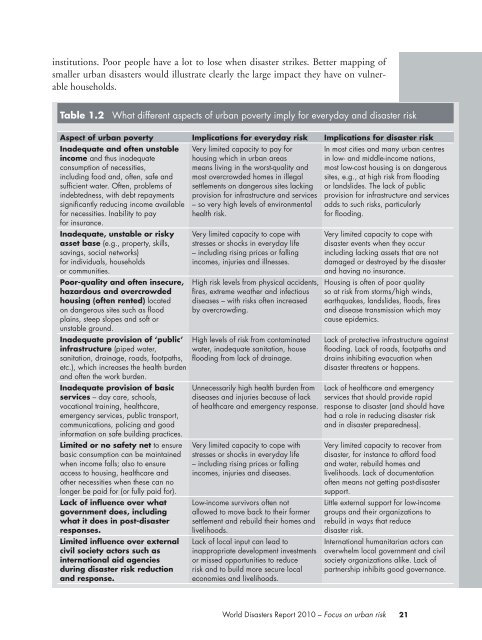World Disasters Report 2010 - International Federation of Red Cross ...
World Disasters Report 2010 - International Federation of Red Cross ...
World Disasters Report 2010 - International Federation of Red Cross ...
Create successful ePaper yourself
Turn your PDF publications into a flip-book with our unique Google optimized e-Paper software.
institutions. Poor people have a lot to lose when disaster strikes. Better mapping <strong>of</strong><br />
smaller urban disasters would illustrate clearly the large impact they have on vulnerable<br />
households.<br />
Table 1.2 What different aspects <strong>of</strong> urban poverty imply for everyday and disaster risk<br />
Aspect <strong>of</strong> urban poverty Implications for everyday risk Implications for disaster risk<br />
Inadequate and <strong>of</strong>ten unstable<br />
income and thus inadequate<br />
consumption <strong>of</strong> necessities,<br />
including food and, <strong>of</strong>ten, safe and<br />
sufficient water. Often, problems <strong>of</strong><br />
indebtedness, with debt repayments<br />
significantly reducing income available<br />
for necessities. Inability to pay<br />
for insurance.<br />
Inadequate, unstable or risky<br />
asset base (e.g., property, skills,<br />
savings, social networks)<br />
for individuals, households<br />
or communities.<br />
Poor-quality and <strong>of</strong>ten insecure,<br />
hazardous and overcrowded<br />
housing (<strong>of</strong>ten rented) located<br />
on dangerous sites such as flood<br />
plains, steep slopes and s<strong>of</strong>t or<br />
unstable ground.<br />
Inadequate provision <strong>of</strong> ‘public’<br />
infrastructure (piped water,<br />
sanitation, drainage, roads, footpaths,<br />
etc.), which increases the health burden<br />
and <strong>of</strong>ten the work burden.<br />
Inadequate provision <strong>of</strong> basic<br />
services – day care, schools,<br />
vocational training, healthcare,<br />
emergency services, public transport,<br />
communications, policing and good<br />
information on safe building practices.<br />
Limited or no safety net to ensure<br />
basic consumption can be maintained<br />
when income falls; also to ensure<br />
access to housing, healthcare and<br />
other necessities when these can no<br />
longer be paid for (or fully paid for).<br />
Lack <strong>of</strong> influence over what<br />
government does, including<br />
what it does in post-disaster<br />
responses.<br />
Limited influence over external<br />
civil society actors such as<br />
international aid agencies<br />
during disaster risk reduction<br />
and response.<br />
Very limited capacity to pay for<br />
housing which in urban areas<br />
means living in the worst-quality and<br />
most overcrowded homes in illegal<br />
settlements on dangerous sites lacking<br />
provision for infrastructure and services<br />
– so very high levels <strong>of</strong> environmental<br />
health risk.<br />
Very limited capacity to cope with<br />
stresses or shocks in everyday life<br />
– including rising prices or falling<br />
incomes, injuries and illnesses.<br />
High risk levels from physical accidents,<br />
fires, extreme weather and infectious<br />
diseases – with risks <strong>of</strong>ten increased<br />
by overcrowding.<br />
High levels <strong>of</strong> risk from contaminated<br />
water, inadequate sanitation, house<br />
flooding from lack <strong>of</strong> drainage.<br />
Unnecessarily high health burden from<br />
diseases and injuries because <strong>of</strong> lack<br />
<strong>of</strong> healthcare and emergency response.<br />
Very limited capacity to cope with<br />
stresses or shocks in everyday life<br />
– including rising prices or falling<br />
incomes, injuries and diseases.<br />
Low-income survivors <strong>of</strong>ten not<br />
allowed to move back to their former<br />
settlement and rebuild their homes and<br />
livelihoods.<br />
Lack <strong>of</strong> local input can lead to<br />
inappropriate development investments<br />
or missed opportunities to reduce<br />
risk and to build more secure local<br />
economies and livelihoods.<br />
<strong>World</strong> <strong>Disasters</strong> <strong>Report</strong> <strong>2010</strong> – Focus on urban risk<br />
In most cities and many urban centres<br />
in low- and middle-income nations,<br />
most low-cost housing is on dangerous<br />
sites, e.g., at high risk from flooding<br />
or landslides. The lack <strong>of</strong> public<br />
provision for infrastructure and services<br />
adds to such risks, particularly<br />
for flooding.<br />
Very limited capacity to cope with<br />
disaster events when they occur<br />
including lacking assets that are not<br />
damaged or destroyed by the disaster<br />
and having no insurance.<br />
Housing is <strong>of</strong>ten <strong>of</strong> poor quality<br />
so at risk from storms/high winds,<br />
earthquakes, landslides, floods, fires<br />
and disease transmission which may<br />
cause epidemics.<br />
Lack <strong>of</strong> protective infrastructure against<br />
flooding. Lack <strong>of</strong> roads, footpaths and<br />
drains inhibiting evacuation when<br />
disaster threatens or happens.<br />
Lack <strong>of</strong> healthcare and emergency<br />
services that should provide rapid<br />
response to disaster (and should have<br />
had a role in reducing disaster risk<br />
and in disaster preparedness).<br />
Very limited capacity to recover from<br />
disaster, for instance to afford food<br />
and water, rebuild homes and<br />
livelihoods. Lack <strong>of</strong> documentation<br />
<strong>of</strong>ten means not getting post-disaster<br />
support.<br />
Little external support for low-income<br />
groups and their organizations to<br />
rebuild in ways that reduce<br />
disaster risk.<br />
<strong>International</strong> humanitarian actors can<br />
overwhelm local government and civil<br />
society organizations alike. Lack <strong>of</strong><br />
partnership inhibits good governance.<br />
21

















